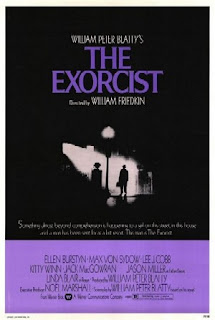Upon release in 1971, William Peter Blatty’s novel The Exorcist became
a literary phenomenon. Not unlike that of another recent bestseller, Mario
Puzo’s The Godfather, it was within a few years adapted for the big screen
by a major studio by one of the leading contemporary filmmakers. Unlike Francis
Ford Coppola’s The Godfather, which won the Academy Award for Best Picture,
William Friedkin’s The Exorcist, though nominated, did not. Even still, the
legacy of this 1973 masterpiece leaves a long, lasting shadow over the entire
horror genre. The Exorcist is one of those unique films in which everyone has a
reaction to it, be it positive or negative. I’ve had people scoff and try to
convince me that they find it funny, but personally I think that’s a nervous
reaction. I find the film to be deeply disturbing, so much so that it’s among a
select group of films that scare me so much I can only watch every year-and-a-half to two years (others off the top of my head include Audition, Suspiria and
Rosemary’s Baby). Like many of the other great films which have ended up my
Hall Of Fame, part of the reason for its effectiveness is that it something
whose final sum is greater than all of the composite elements. It’s got great
performances from Ellen Burstyn, Jason Miller, Max von Sydow and Linda Blair,
all of whom generate empathy with their characters, is a film of technical
wizardry, makes excellent use of sound design and has a great duo in the
uncompromising Friedkin as director and Blatty as screenwriter adapting his own
novel. Upon release in 1973, The Exorcist had people throwing themselves into
the aisles in horror. In 2016, it’s still one of the most frightening things
I’ve seen.

No comments:
Post a Comment